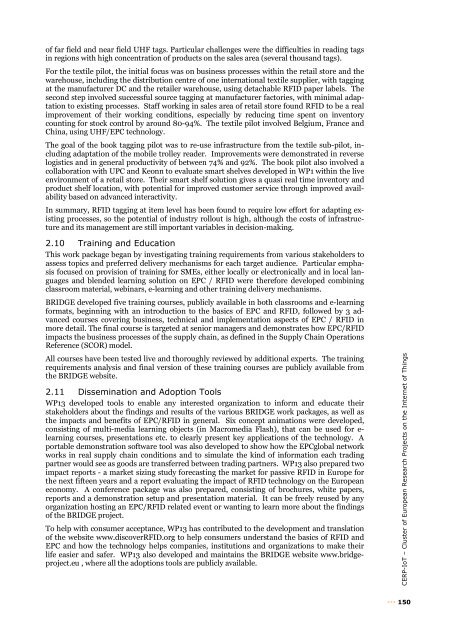Vision and Challenges for Realising the Internet of Things
Vision and Challenges for Realising the Internet of Things
Vision and Challenges for Realising the Internet of Things
Create successful ePaper yourself
Turn your PDF publications into a flip-book with our unique Google optimized e-Paper software.
<strong>of</strong> far field <strong>and</strong> near field UHF tags. Particular challenges were <strong>the</strong> difficulties in reading tags<br />
in regions with high concentration <strong>of</strong> products on <strong>the</strong> sales area (several thous<strong>and</strong> tags).<br />
For <strong>the</strong> textile pilot, <strong>the</strong> initial focus was on business processes within <strong>the</strong> retail store <strong>and</strong> <strong>the</strong><br />
warehouse, including <strong>the</strong> distribution centre <strong>of</strong> one international textile supplier, with tagging<br />
at <strong>the</strong> manufacturer DC <strong>and</strong> <strong>the</strong> retailer warehouse, using detachable RFID paper labels. The<br />
second step involved successful source tagging at manufacturer factories, with minimal adaptation<br />
to existing processes. Staff working in sales area <strong>of</strong> retail store found RFID to be a real<br />
improvement <strong>of</strong> <strong>the</strong>ir working conditions, especially by reducing time spent on inventory<br />
counting <strong>for</strong> stock control by around 80-94%. The textile pilot involved Belgium, France <strong>and</strong><br />
China, using UHF/EPC technology.<br />
The goal <strong>of</strong> <strong>the</strong> book tagging pilot was to re-use infrastructure from <strong>the</strong> textile sub-pilot, including<br />
adaptation <strong>of</strong> <strong>the</strong> mobile trolley reader. Improvements were demonstrated in reverse<br />
logistics <strong>and</strong> in general productivity <strong>of</strong> between 74% <strong>and</strong> 92%. The book pilot also involved a<br />
collaboration with UPC <strong>and</strong> Keonn to evaluate smart shelves developed in WP1 within <strong>the</strong> live<br />
environment <strong>of</strong> a retail store. Their smart shelf solution gives a quasi real time inventory <strong>and</strong><br />
product shelf location, with potential <strong>for</strong> improved customer service through improved availability<br />
based on advanced interactivity.<br />
In summary, RFID tagging at item level has been found to require low ef<strong>for</strong>t <strong>for</strong> adapting existing<br />
processes, so <strong>the</strong> potential <strong>of</strong> industry rollout is high, although <strong>the</strong> costs <strong>of</strong> infrastructure<br />
<strong>and</strong> its management are still important variables in decision-making.<br />
2.10 Training <strong>and</strong> Education<br />
This work package began by investigating training requirements from various stakeholders to<br />
assess topics <strong>and</strong> preferred delivery mechanisms <strong>for</strong> each target audience. Particular emphasis<br />
focused on provision <strong>of</strong> training <strong>for</strong> SMEs, ei<strong>the</strong>r locally or electronically <strong>and</strong> in local languages<br />
<strong>and</strong> blended learning solution on EPC / RFID were <strong>the</strong>re<strong>for</strong>e developed combining<br />
classroom material, webinars, e-learning <strong>and</strong> o<strong>the</strong>r training delivery mechanisms.<br />
BRIDGE developed five training courses, publicly available in both classrooms <strong>and</strong> e-learning<br />
<strong>for</strong>mats, beginning with an introduction to <strong>the</strong> basics <strong>of</strong> EPC <strong>and</strong> RFID, followed by 3 advanced<br />
courses covering business, technical <strong>and</strong> implementation aspects <strong>of</strong> EPC / RFID in<br />
more detail. The final course is targeted at senior managers <strong>and</strong> demonstrates how EPC/RFID<br />
impacts <strong>the</strong> business processes <strong>of</strong> <strong>the</strong> supply chain, as defined in <strong>the</strong> Supply Chain Operations<br />
Reference (SCOR) model.<br />
All courses have been tested live <strong>and</strong> thoroughly reviewed by additional experts. The training<br />
requirements analysis <strong>and</strong> final version <strong>of</strong> <strong>the</strong>se training courses are publicly available from<br />
<strong>the</strong> BRIDGE website.<br />
2.11 Dissemination <strong>and</strong> Adoption Tools<br />
WP13 developed tools to enable any interested organization to in<strong>for</strong>m <strong>and</strong> educate <strong>the</strong>ir<br />
stakeholders about <strong>the</strong> findings <strong>and</strong> results <strong>of</strong> <strong>the</strong> various BRIDGE work packages, as well as<br />
<strong>the</strong> impacts <strong>and</strong> benefits <strong>of</strong> EPC/RFID in general. Six concept animations were developed,<br />
consisting <strong>of</strong> multi-media learning objects (in Macromedia Flash), that can be used <strong>for</strong> elearning<br />
courses, presentations etc. to clearly present key applications <strong>of</strong> <strong>the</strong> technology. A<br />
portable demonstration s<strong>of</strong>tware tool was also developed to show how <strong>the</strong> EPCglobal network<br />
works in real supply chain conditions <strong>and</strong> to simulate <strong>the</strong> kind <strong>of</strong> in<strong>for</strong>mation each trading<br />
partner would see as goods are transferred between trading partners. WP13 also prepared two<br />
impact reports - a market sizing study <strong>for</strong>ecasting <strong>the</strong> market <strong>for</strong> passive RFID in Europe <strong>for</strong><br />
<strong>the</strong> next fifteen years <strong>and</strong> a report evaluating <strong>the</strong> impact <strong>of</strong> RFID technology on <strong>the</strong> European<br />
economy. A conference package was also prepared, consisting <strong>of</strong> brochures, white papers,<br />
reports <strong>and</strong> a demonstration setup <strong>and</strong> presentation material. It can be freely reused by any<br />
organization hosting an EPC/RFID related event or wanting to learn more about <strong>the</strong> findings<br />
<strong>of</strong> <strong>the</strong> BRIDGE project.<br />
To help with consumer acceptance, WP13 has contributed to <strong>the</strong> development <strong>and</strong> translation<br />
<strong>of</strong> <strong>the</strong> website www.discoverRFID.org to help consumers underst<strong>and</strong> <strong>the</strong> basics <strong>of</strong> RFID <strong>and</strong><br />
EPC <strong>and</strong> how <strong>the</strong> technology helps companies, institutions <strong>and</strong> organizations to make <strong>the</strong>ir<br />
life easier <strong>and</strong> safer. WP13 also developed <strong>and</strong> maintains <strong>the</strong> BRIDGE website www.bridgeproject.eu<br />
, where all <strong>the</strong> adoptions tools are publicly available.<br />
CERP-IoT – Cluster <strong>of</strong> European Research Projects on <strong>the</strong> <strong>Internet</strong> <strong>of</strong> <strong>Things</strong><br />
150
















